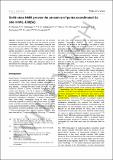Files in this item
Solid-state NMR spectroscopy proves the presence of penta-coordinated Sc sites in MIL-100(Sc)
Item metadata
| dc.contributor.author | Giovine, Raynald | |
| dc.contributor.author | Volkringer, Christophe | |
| dc.contributor.author | Ashbrook, Sharon E. | |
| dc.contributor.author | Trébosc, Julien | |
| dc.contributor.author | McKay, David | |
| dc.contributor.author | Loiseau, Thierry | |
| dc.contributor.author | Amoureux, Jean-Paul | |
| dc.contributor.author | Lafon, Olivier | |
| dc.contributor.author | Pourpoint, Frédérique | |
| dc.date.accessioned | 2018-05-24T23:32:43Z | |
| dc.date.available | 2018-05-24T23:32:43Z | |
| dc.date.issued | 2017-07-18 | |
| dc.identifier | 250163703 | |
| dc.identifier | 9e0ce91f-da3c-46d1-b74e-4d253314939a | |
| dc.identifier | 85019867962 | |
| dc.identifier | 000405695400015 | |
| dc.identifier.citation | Giovine , R , Volkringer , C , Ashbrook , S E , Trébosc , J , McKay , D , Loiseau , T , Amoureux , J-P , Lafon , O & Pourpoint , F 2017 , ' Solid-state NMR spectroscopy proves the presence of penta-coordinated Sc sites in MIL-100(Sc) ' , Chemistry - A European Journal , vol. 23 , no. 40 , pp. 9525-9534 . https://doi.org/10.1002/chem.201700584 | en |
| dc.identifier.issn | 1521-3765 | |
| dc.identifier.other | Bibtex: urn:7dea522d13cc1b637885dd367ee9fd0b | |
| dc.identifier.other | ORCID: /0000-0003-0362-7848/work/33547628 | |
| dc.identifier.other | ORCID: /0000-0002-4538-6782/work/56638915 | |
| dc.identifier.uri | https://hdl.handle.net/10023/13531 | |
| dc.description | Chevreul Institute (FR 2638), Ministère de l′Enseignement Supérieur et de la Recherche, Région Hauts-de-France, and FEDER are acknowledged for supporting and partially funding this work. Authors are also grateful for funding supported by contract ANR-14-CE07-0009-01. | en |
| dc.description.abstract | Advanced solid-state NMR methods and first-principles calculations demonstrate for the first time the formation of penta-coordinated scandium sites. These coordinatively unsaturated sites were shown during the thermal activation of scandium-based metal-organic frameworks (MOFs). A 45Sc NMR experiment allows their specific observation in activated Sc3BTB2 (H3BTB=1,3,5-tris(4-carboxyphenyl)benzene) and MIL-100(Sc) MOFs. The assignment of the ScO5 groups is supported by the DFT calculations of NMR parameters. The presence of ScO5 Lewis acid sites in MIL-100(Sc) explains furthermore its catalytic activity. The first NMR experiment to probe 13C−45Sc distances is also introduced. This advanced solid-state NMR pulse sequence allows the demonstration of the shrinkage of the MIL-100(Sc) network when the activation temperature is raised. | |
| dc.format.extent | 1780448 | |
| dc.language.iso | eng | |
| dc.relation.ispartof | Chemistry - A European Journal | en |
| dc.subject | Density functional calculations | en |
| dc.subject | Metal–organic frameworks | en |
| dc.subject | MIL-100(Sc) | en |
| dc.subject | ScO5 | en |
| dc.subject | 13C−45Sc | en |
| dc.subject | QD Chemistry | en |
| dc.subject | NDAS | en |
| dc.subject.lcc | QD | en |
| dc.title | Solid-state NMR spectroscopy proves the presence of penta-coordinated Sc sites in MIL-100(Sc) | en |
| dc.type | Journal article | en |
| dc.contributor.institution | University of St Andrews. School of Chemistry | en |
| dc.contributor.institution | University of St Andrews. EaSTCHEM | en |
| dc.identifier.doi | 10.1002/chem.201700584 | |
| dc.description.status | Peer reviewed | en |
| dc.date.embargoedUntil | 2018-05-24 | |
| dc.identifier.url | http://onlinelibrary.wiley.com/doi/10.1002/chem.201700584/full#footer-support-info | en |
This item appears in the following Collection(s)
Items in the St Andrews Research Repository are protected by copyright, with all rights reserved, unless otherwise indicated.

